Darrell Brooks trial: Jury begins deliberations after closing arguments
WAUKESHA, Wis. - Jurors in the Darrell Brooks trial came to court on Tuesday, Oct. 25 with overnight bags. Brooks is accused in the Waukesha Christmas parade attack in November 2021.
Jurors began deliberations by the end of the day. First, they had to get through five to six hours of jury instructions read to them by Judge Jennifer Dorow before closing arguments from the prosecution and Brooks.
Six recesses before lunch break
Before the jury could be brought into the courtroom, Brooks argued with Judge Dorow about matters such as subject matter jurisdiction and other evidence. The judge said she was not going to have this discussion or debate.
"That opportunity has closed for you sir," the judge said. "The record speaks for itself."
Judge Dorow then warned Brooks if he started talking about subject matter jurisdiction in front of the jury, she would excuse the jurors and Brooks would be sent to the adjacent courtroom. At that point, the judge took a five-minute break.
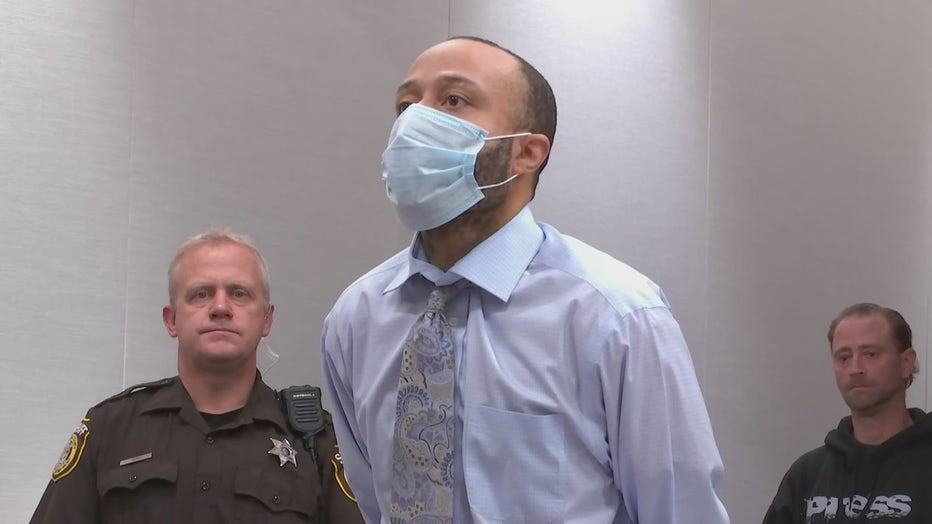
Darrell Brooks
Just as the jury was being brought into the courtroom after the break, Brooks began talking about subject matter jurisdiction once again. The judge immediately sent the jury back out of the courtroom. Judge Dorow asked Brooks if he could not interrupt or make statements during the reading of the jury instructions. Because he would not answer appropriately, the judge ordered Brooks to be put in the adjacent courtroom so that the jury instructions could be read without interruption.
When court returned, Brooks was indeed in the adjacent courtroom, and the judge described for the record as to why he was there. The jury was present for this.
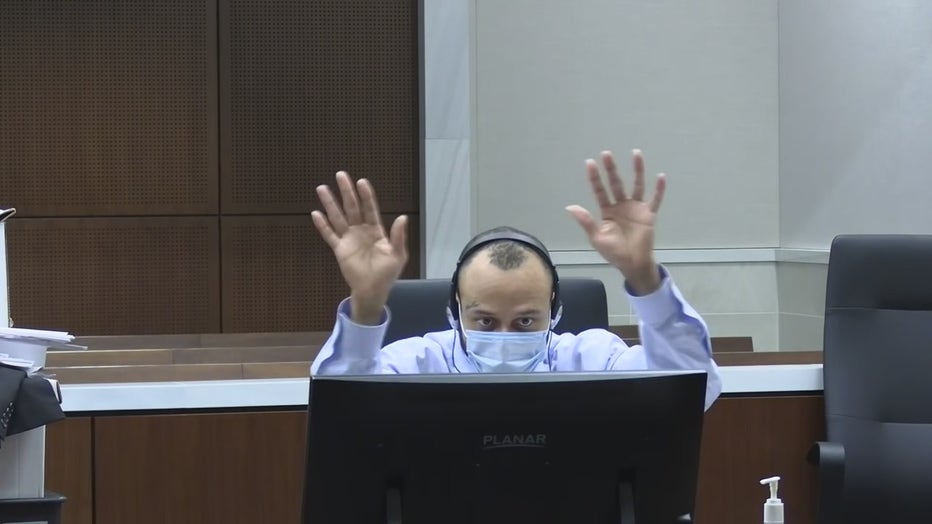
Darrell Brooks
However, during this process, Brooks could be seen waving his arms in the adjacent. He told bailiffs that he, indeed, wanted to be present for the reading of the jury instructions and once again, the judge put the court in a brief recess to make this possible.
Moments later, with the jury at the courtroom door, the judge ordered a fourth break because Brooks began speaking out of turn once again, talking about subject matter jurisdiction. Dorow said, "If you say one word…" and Brooks did.
A fifth break came a short time after that after Brooks waved his hands again saying he wanted to come back to the main courtroom. The judge ordered him to write down his request and pledge not to interrupt the proceedings any further.
Shortly before 10 a.m., Judge Dorow brought the court back to order with the jury present. She said Brooks did send a letter but did not pledge to respect decorum, so he remained in the courtroom next door. She began the five- to six-hour process of reading through jury instructions. Brooks was muted in the adjacent courtroom.
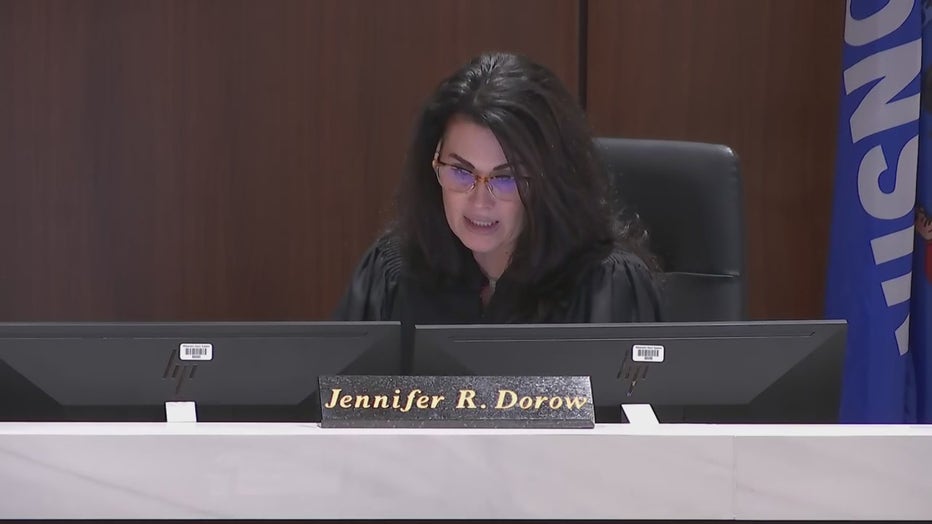
Judge Jennifer Dorow
Following what the judge described as a "comfort break" during the reading of jury instructions, Brooks indicated he wanted to return to the main court. A sixth break was ordered to bring Brooks back to the main courtroom.
When court resumed, Brooks was still in the adjacent courtroom.
"We have lost a significant amount of time now," Dorow noted.
Nearly an hour passed since the "comfort break" when Dorow was on page 41 of 107 of jury instructions.
Brooks remained in the adjacent courtroom – muted – while the remainder of the jury instructions were read aloud.
Brooks waved his hands in the adjacent courtroom along with his Bible, trying to get Dorow's attention. She told the jury she would address Brooks later and continued reading the jury instructions.
Dorow finished with the first 73 pages of jury instructions before lunch.
Brooks brings up old arguments, says it's a ‘whole new day’
As court resumed, Brooks, in the main courtroom, wasted half an hour asking questions that had been answered for weeks.
"This is a whole new day, your Honor," said Brooks.
Brooks mentioned something about Social Security and maritime law and the placement of the fringe/eagle on the flag in the courtroom. Brooks said the court had yet to address subject matter jurisdiction.
On Monday, Brooks told the court the eagle atop the flag was a "military symbol," relating to Brooks' sovereign citizen arguments he presented throughout the trial. Sovereign citizen theorists suggest gold-fringed flags in courtrooms prove that the courts are, in fact, structures of the military.
Judge Dorow mentioned a change to the jury instructions about implicit bias.
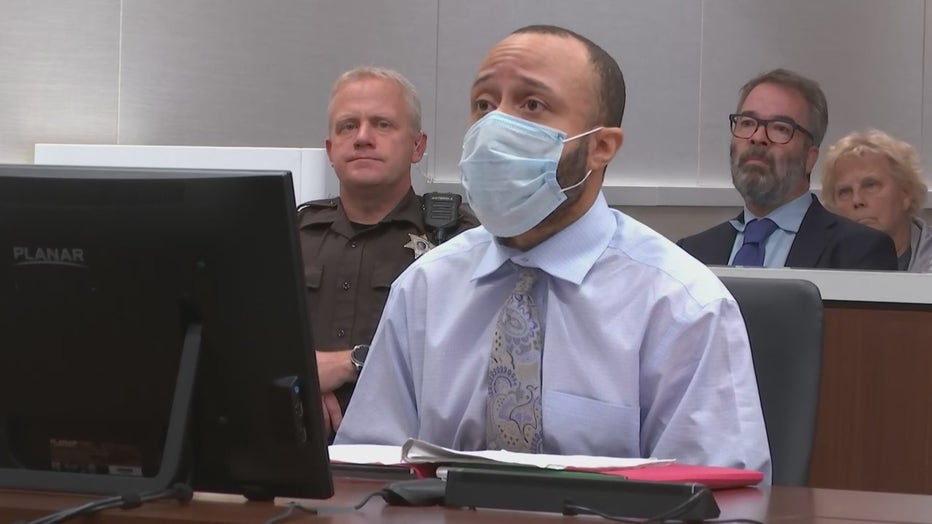
Darrell Brooks in court Tuesday, Oct. 25
Brooks then brought up "filings" related to "notice of appearances, my bond," requests he had made before.
"Denied. It's not relevant," said Judge Dorow.
"Not even your oath of office?" asked Brooks.
"It's not relevant to this case," said Judge Dorow.
"The jury should know the truth…" said Brooks.
"I’m going to let the jury know the truth," Brooks continued. "I have the right to inform them of their rights and duties under the Constitution."
"Do you intend to bring this up before the jury comes out?" asked Dorow.
The judge advised the defendant it was possible he could forfeit his right to present a closing argument, noting he would not be allowed to bring up jury nullification or subject matter jurisdiction in his closing.
As the jury was coming in, Brooks yelled, "Take me to the next courtroom!"
Brooks forfeits right to be present for state's closing
At that point, Dorow said Brooks had forfeited his right to be present for the state's closing. He was sent to the adjacent courtroom and the court went into a brief break.
"Mr. Brooks was brought to the main courtroom, and during that almost 35 minutes or so, he was insistent on raising a variety of legal issues which this court has either previously addressed or which are meritless and do not warrant any further response…," Dorow said.
She added that this was not the time for an offer of proof like Brooks was requesting.
"This court has been attempting, frankly, all day, to get through the reading of jury instructions, to get to the part where the parties make closing arguments and to get the case into the jury’s hands. It has been challenging…," Dorow said.
Dorow described Brooks as stubbornly defiant with no respect for the fact a ruling has been made.
"In an effort to simply put him on notice regarding his behavior… the court was attempting to set some parameters regarding closing arguments so that they are focused, so that they are proper, and so that they follow the law…," Dorow said.
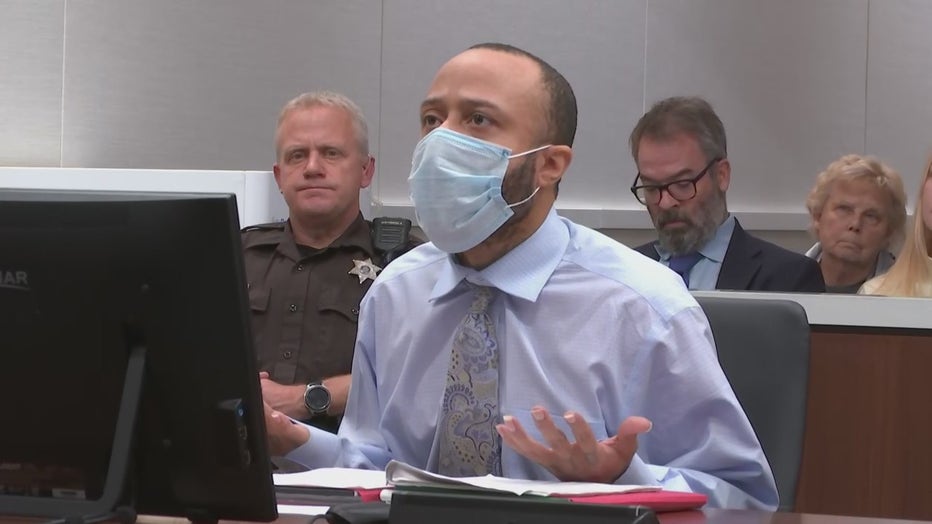
Darrell Brooks in court Tuesday, Oct. 25
Dorow noted Brooks has rights but said they are not in a vacuum.
"This case has demonstrated that a stubbornly defiant defendant can forfeit even important constitutional rights by conduct," the judge said.
Dorow said she hoped she would not have to go through a decision that finds he forfeited his right to make a closing argument.
"I will certainly wait to see how that goes," Dorow said, noting he was respectful during his opening statement and made a variety of points. "I would hope that he follows some of those same things here when he does his closing argument."
"What I truly believe is an effort on his part to continue to delay and lengthen these proceedings," the judge added.
As the judge discussed the importance of decorum in the court, Brooks stood and stared with his eyes up. He was seen pointing out things in his courtroom.
Dorow said she’s adjusted some of her courtroom’s cameras so that he could see things. She said with the technology she had available, it was the functional equivalent of Brooks appearing in the same courtroom. The prosecution asked to have the audio/video in the adjacent courtroom tested. Opper said she planned to use a PowerPoint presentation in her closing. The test was successful.
The judge noted his lengthy history of talking over her while she attempted to make an adequate record throughout the trial.
"I know he disagrees with my ability to do that, but I believe it is consistent with ensuring order, dignity and decorum," said Dorow.
She advised Brooks he could reclaim the right to be present as soon as he was willing to conduct himself within decorum standards, including not interrupting the court and respecting the court’s decisions by way of oral ruling, even if he disagreed with that.
The judge said she would unmute Brooks when the jury came out, noting a few more jury instructions to go through before closing arguments.
District Attorney Sue Opper presents state's closing argument
Opper began the state's closing by thanking the jury.
"There’s no one in this courtroom that does not realize the sacrifice that you made serving your community in this very important task," said Opper.
Opper then told the jury the prosecution does "represent someone."
"We represent the people of Wisconsin," said Opper. "People enact laws. People want to feel safe. People have representatives in Madison or Washington, D.C. that set standards, rules, that we all are expected to live by, and when those rules are violated, prosecutors step in and enforce the law. Darrell Brooks does not represent anybody. He does not have a client. Darrell Brooks is the client. Darrell Brooks is the defendant. The State of Wisconsin is the plaintiff. It’s really that simple, and it’s consistent with any other criminal case you’ve heard about."
The district attorney told the jury, "I’m going to ask you for your guilty vote at the end of my comments."
Brooks objected, saying Opper's statements were a "mischaracterization of who I am."
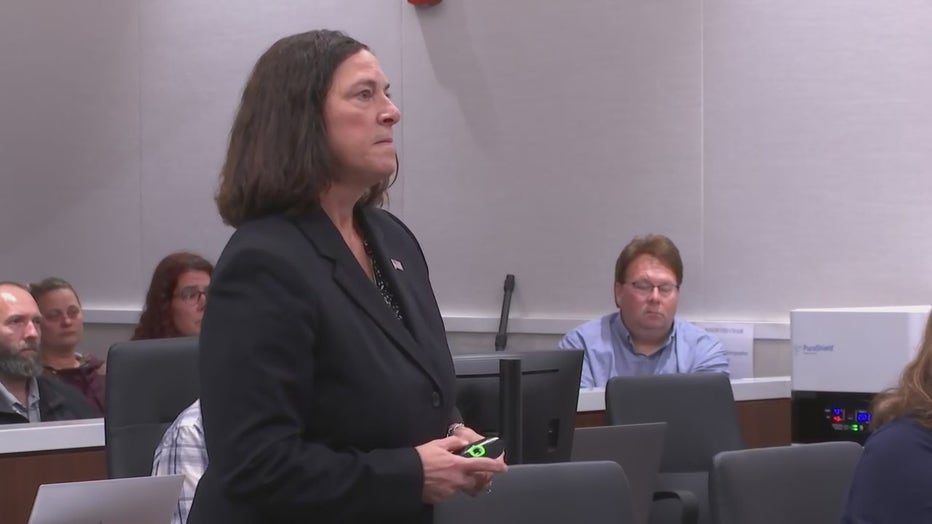
Closing argument by District Attorney Sue Opper
"You must not, not, not consider anything about Darrell Brooks other than his conduct in downtown Waukesha on the evening of Nov. 21, 2021," said Opper. "Nothing he’s done before that. Nothing he’s done since then. Is he guilty of the 76 counts that he’s been charged with? That and solely that should be the topic of your discussion."
Opper then began summarizing the 76 counts filed against Brooks in this case.
Opper referenced the map shown by the state during the presentation of their case-in-chief, noting the jury could have that in the jury room during their deliberations.
"And it will take you, as we did in our presentation of the case, right down Main Street and address all the counts that were involved," said Opper.
As for the six counts of first-degree intentional homicide, Opper named the six victims killed in the parade attack: Ginnie Sorenson, Lee Owen, Tamara Durand, Jane Kulich, Bill Hospel and Jackson Sparks.
As for the 61 counts of first-degree recklessly endangering safety, Opper said, "Everybody up and down the street, I would argue, had their safety endangered that day. I didn’t charge 5,000 counts. We selected 61 counts of people that we can identify by name, in exhibit 15, that were injured by the conduct of Mr. Brooks."
Opper referenced the separate groups impacted by the parade attack, including the Waukesha South High School Band, the Xtreme Dance Team and the Milwaukee Dancing Grannies.
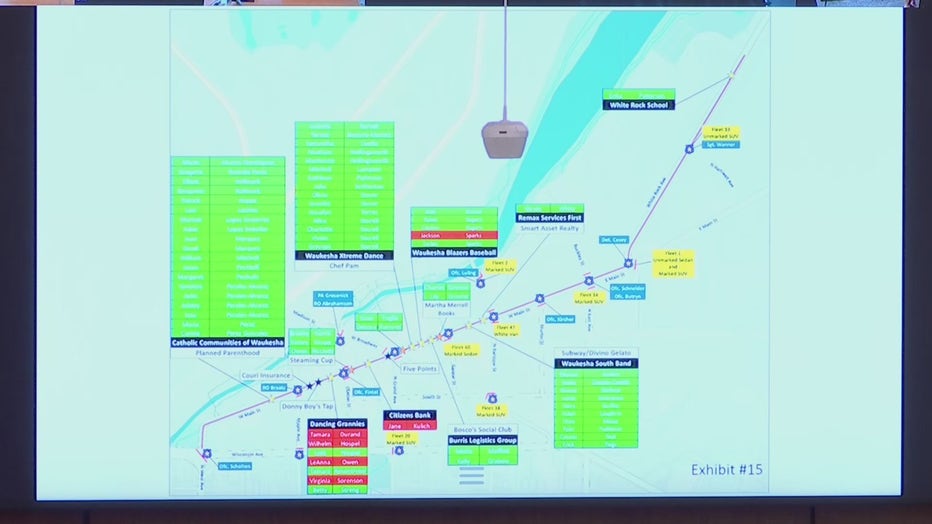
State's map of Waukesha Christmas parade attack
"You can just see the names and match it up to who was injured and killed, versus who wasn’t," said Opper.
What was he thinking? Why did he do this? Again, those are things I don’t necessarily have to prove to you. His intent, I do have to prove, and I submit without any doubt there’s overwhelming evidence that this was an intentional act by Darrell Brooks and an act of utter disregard for human life," said Opper.
"Number one, first and foremost, just stop driving," Opper continued. "That’s it. It’s really that simple. Not one person had to be hurt that day if he had just stopped driving."
Brooks objected, referencing jury instructions about looking into someone’s mind. The objection was overruled by the judge.
Opper then referenced Sgt. David Wanner, the state's first witness, and the state's exhibits showing the positions of officers and barricades.
"How do I know it was intentional? Because even Darrell Brooks told Det. Carpenter, ‘I could tell something was going on downtown,'" said Opper. "No reasonable person would drive to this area, see the squads with their reds and blues on, see the officers with their vests… see the floats lining up and the participants getting ready and not know to drive safely, slowly and obey officers."

Waukesha South High School band
Opper said the barricades, officers, participants and spectators all helped to prove this was intentional. Brooks' objection was overruled.
"Honking the horn, quite interesting that Mr. Brooks asked so many witnesses if they heard the horn honking. Some of them said they did… Most of them said they didn’t," said Opper. "The horn honking cuts both ways, folks. If he’s honking his horn, that means he can see something’s in front of him. That means he knows there’s an object in the road… If you see something in the road, and you want to alert the other person to your presence, you will honk but you do not then have the green light to just keep going if they do not move. He knew they were there – intent."
"We heard testimony from four different police officers standing in four different spots near here, telling of their four different efforts to stop him. Intentional," Opper continued.
Opper pointed out where Sgt. Wanner was and that he testified that the SUV blew past him. Detective Casey then testified he was close enough to put his hand on the car. The SUV kept going. Near South and Buckley, Officer Schneider and Officer Butryn made separate efforts to stop the SUV.
"And he keeps going," said Opper. "Four police officers. It's intentional. He had plenty of opportunity to just stop anywhere along the way. If this was an accident… at any point, all he had to do is stop. They could have paused the parade. They could have moved the barricades and escorted him out. He didn’t. It was intentional. He went on for four blocks, four blocks. It was intentional.
"He reached speeds of approximately 30 miles per hour. That’s intentional. He plowed through 68 different people, 68. How can you hit one and keep going? How can you hit two and keep going? How can you hit three and keep going? Didn’t faze him a bit. He kept going until he got to the end and there was no one else to hit," Opper continued.
Opper then turned to Brooks' alleged conduct after the parade.
"His desperation to run...get the hell out of town as fast as he could before the cops came. That shows his intent," said Opper.
"Never once did he say, like he told you in his opening statement, that it wasn’t intentional…" said Opper. "No, he came up with some convoluted story that I came out here in a tan Kia, and then I went to meet up with Erika… absolutely nonsensical story. Does not match up with the evidence in this case."
Opper played a clip from the parade in which the sound of "Jingle Bell Rock" could be heard.
"I thought it really captured the environment that so many witnesses tried to explain to you, right? It’s a Christmas parade. People are there with their families… Strangers standing next to strangers. That’s what’s going on on Main Street," said Opper.
She then referenced Brooks' alleged reckless driving even before the parade.
"While the units are marching down Main Street entertaining the crowd, Darrell Brooks is driving recklessly. He’s enraged, and he’s arguing with Erika Patterson… This is important because before he even gets to the parade route, this is how he’s driving. He’s driving the wrong way down North Street, and then acts like it’s everybody else’s fault in the world," said Opper.
Opper then showed video of the fight prosecutors say happened near Frame Park before the Christmas parade attack, noting a visible "pushing attack."
"That’s it. He drives off onto the parade route. From this moment right here on Exhibit 15... he’s enraged. He’s angry. Flips up that hood and he zooms past Sgt. Wanner, past Officer Casey, onto the parade route. Now, there’s no doubt for the first two blocks he does not strike anyone… Some even say he was driving at a reasonable speed initially. Clearly, once he gets past Barstow, that’s where it starts, right? That’s where it starts. Nicole White, our first victim walking with ReMax… knocks her over and keeps going," said Opper.
"Next, Waukesha South Band. Hits the Greene kids watching on the sidewalk. Runs over Kelly Grabow and her daughter. Plows through the Xtreme Dance Team before Five Points. Hits Debora Ramirez and her son, Isaac. Keeps going. Hits Jane Kulich square on, causing her to go on the hood of the car and then fall off and drives over her body. He doesn’t stop. He keeps going… hits the kids by the Steaming Cup. Keeps going. Plows through the Dancing Grannies in that zig-zag fashion, striking most of them, injuring them, killing them. Keeps going. Gets to the end and goes through the Catholic Community.
Opper referenced testimony saying 15-20 people went into the air and looked like "bowling pins."
"It’s a terrible description when you think that these are human beings, but that’s exactly what it looked like," said Opper. "I’m not telling you he set out that morning to cause this carnage, but when he became enraged… he didn’t give a damn."
Opper mentioned she doesn’t know why he did this, "other than the rage."
Opper added that Brooks was right in that the jurors could not read minds, telling the jury that "the law does not require you to."
Opper played video showing the SUV hitting Nicole White, the first victim at the parade. She pointed to the events after that as proving intent.
"That’s intent, folks! No reasonable person is going to come across a group of teenagers playing band instruments, drive over them and keep going," said Opper.
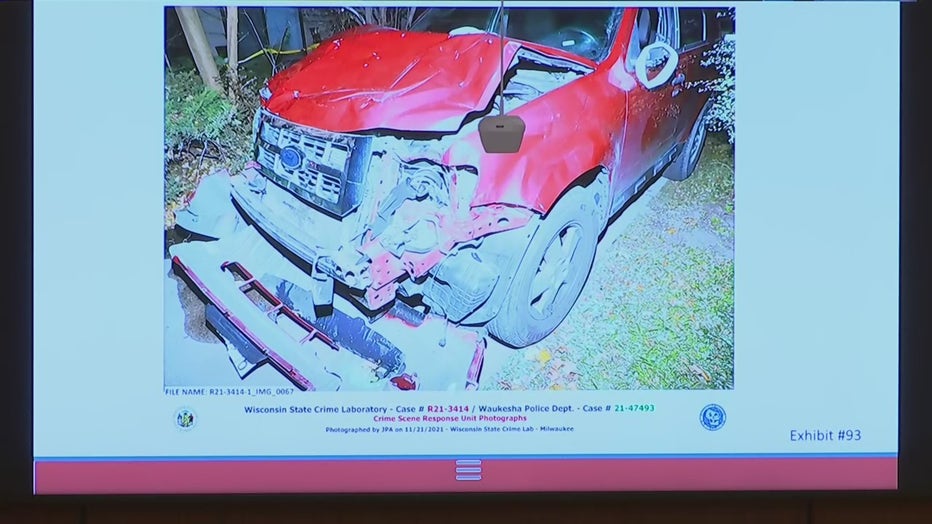
Red SUV
Opper then referenced the red SUV, which the jury saw during the trial.
"We asked for time for you to go look at this car in person… because it’s remarkable that this damage was caused by human beings," said Opper.
She showed another exhibit and referenced shoes laying in the street at the end of the parade.
"All of the shoes laying there because of the velocity… the power that these people were knocked right out of their shoes. That’s intent," said Opper.
Opper showed home surveillance video of Brooks near a home after the parade. Brooks says, "Excuse me," in that video.
"Intent. What’s he running from? What’s he running from if he’s just a lost guy with no ride back to Milwaukee? What’s he running from as there’s cop’s sirens wailing in the background?" said Opper.
Opper then referenced Brooks' actions on Maple before his arrest, when prosecutors say he went door-to-door asking for a phone to call an Uber.
"Again, the desperation, whether he had to ask or use veiled threats like, ‘I won’t hurt you, but I need your phone.’ He was absolutely desperate to get out of there until he took refuge in the home of Daniel Rider," said Opper.
Rider testified that he invited Brooks into his home and had no idea what had happened at the parade.
"It’s actually probably a really good thing that he took him in because it stalled [him]... until the cops could close in and get there," said Opper.
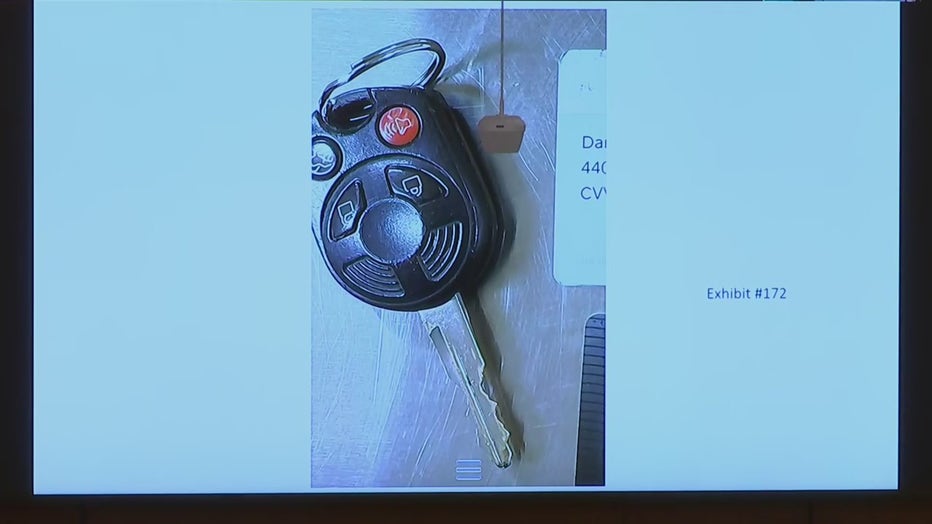
Black Ford key
Opper showed the jury an image from a music video showing Brooks and the red SUV. She showed a photo of the black Ford key prosecutors say was found on Brooks after the parade attack. She held up a sweatshirt that DNA analysts testified had Brooks' DNA on it.
"There’s clearly one person in that vehicle in every one of these photos, and it’s that man... Darrell Edward Brooks Jr., date of birth on his identification card issued by the State of Wisconsin! This was in his pocket when they arrested him, so this entire shenanigans that he’s presented to you about 'I’m not Darrell Brooks,' 'That’s not my name' and 'I don’t know who that is' and 'I don't consent to being called that name,' it’s nothing but a distraction. It’s Darrell Brooks. It’s the man who drove through the Waukesha Christmas Parade and killed people," said Opper.
Brooks objected, saying her language regarding "shenanigans" was over the top. The judge overruled the objection.
Opper wrapped up her closing argument with "a stitched together video of all the carnage caused by Darrell Brooks."
"And I apologize. This is important that you know what he did," said Opper.
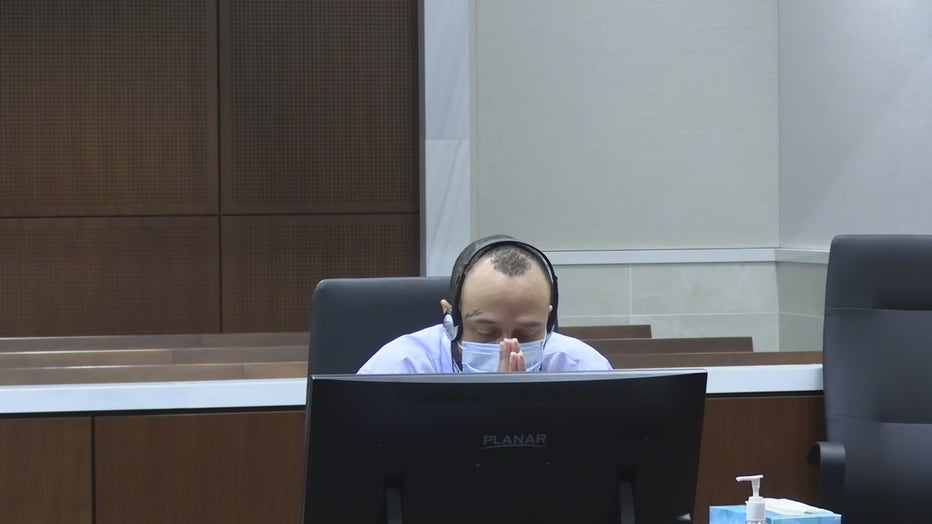
Darrell Brooks in court Tuesday, Oct. 25
"It’s important that you think about the women like Nicole White, and Kelly Grabow and her daughter and Jane Kulich who were just there with friends and co-workers supporting a local business; the teenagers marching in the band wearing their school colors; the boys and girls with the Blazers baseball team and their coaches doing nothing more than handing out baseball cards; the young girls in the Xtreme Dance Team. Can you imagine how many hours they spent trying to learn that routine? And he drove right through them without a care in the world. The Grannies dancing right down the street in perfect step, every one of them. The Catholic Community. It’s time for Darrell Brooks to stop running. It’s time for him to stop lying. It’s time for him to be held accountable for his actions. Darrell Brooks cowardly rammed his SUV through this parade," said Opper.
"Please, I ask you to add up the evidence. Use the map You can check off the names. We’ve covered them all. Walk down that street like we did with you. Return guilty verdicts on all counts, please," Opper concluded.
After state's closing, Brooks seeks to address subject matter jurisdiction
Back in the main courtroom, when asked whether he was prepared to present his closing arguments, Brooks said he was ready to address subject matter jurisdiction. It was denied by Judge Dorow, who referred to her written decision on this matter.
Brooks claimed he did not have it, and the judge said she would have her clerk prepare another copy "as a courtesy."
Brooks said he "accepts for value and returns for value this document, as it does not reflect lawful law."
Dorow told Brooks the jury had been asked to come out, and he should "please be prepared with your closing argument."
As the jury entered, Brooks asked whether it was a tacit agreement not to answer any questions as a public servant.
Dorow then instructed Brooks to begin his closing argument. The defendant said he was not ready. He said he did not understand why questions brought up with the jury absent were not answered.
"Sir, this is your opportunity to provide your closing argument to the jury," Dorow said.
Dorow said she would inform the jury of the law.
Brooks asked whether she would inform the jury they could nullify the law. Dorow said he had no right to make that argument.
The judge then excused the jury.
‘Jury nullification’ argument
With the jury absent, Dorow told Brooks he had no right to inform the jury they had the right to nullify, referencing case law. He said he could not tell the jury to disregard the law and could not say the phrase "jury nullification."
According to Cornell Law, "jury nullification refers to a jury's knowing and deliberate rejection of the evidence or refusal to apply the law either because the jury wants to send a message about some social issue that is larger than the case itself, or because the result dictated by law is contrary to the jury's sense of justice, morality, or fairness. Essentially, with jury nullification, the jury returns a "not guilty" verdict even if jurors believe beyond a reasonable doubt that the defendant broke the law."
"The time has come for you to give your closing argument. If you choose not to do so at this time, then you will forfeit your right to do so based on your conduct," said Dorow.
Brooks said he hadn't made any choice, he had not waived his constitutional right and would not let Dorow "coerce me" as a public servant, to do that.
"Sir, the time has come for you to present your closing argument," said Dorow.
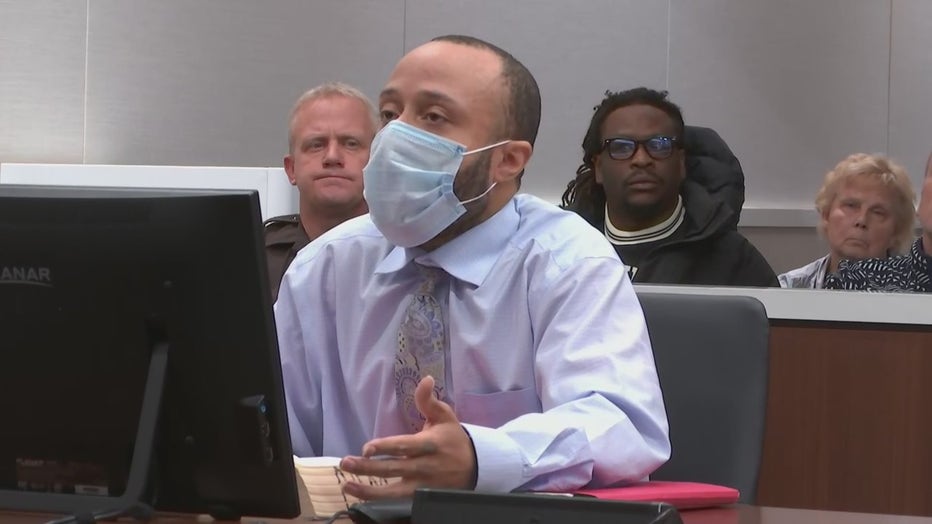
Darrell Brooks in court Tuesday, Oct. 25
Brooks asked if she was making a judicial determination. Dorow cited case law in informing Brooks he could forfeit his right to a closing argument under the law by "conduct."
"The time has now come for you to present a closing argument. There will be no further delays. I will not be taking any further adjournments for you to prepare," said Dorow.
The judge noted Brooks was brought back into the main courtroom to deliver his closing argument. She again told them he could not refer to jury nullification. Brooks said he would be let the jury know they have rights and should be notified of the truth.
"No party has the right to argue for jury nullification," said Dorow, reading from case law.
"You are not allowed to inform them of their power to nullify," said Dorow. "That is not a right that you have, sir."
Dorow said jury nullification was an inherent power the jury had, and they were not to be instructed on that.
The judge said in jury instructions, there’s a law note on jury nullification saying it’s improper for a court to allow a defendant or a defense attorney to make an argument or make the jury aware that they have the power to nullify a verdict.
Brooks said they had a whole conversation about him bringing up jury nullification Monday night. Dorow said Brooks was defiantly disregarding this court.
"It’s ridiculous, your Honor. You just stated they have the power to nullify any law," Brooks said.
Amid interruptions, Dorow said she was trying her best not to move Brooks to another courtroom but noted that was often her best option to make a record without him interrupting her.
"Whatever verbiage you want to put in front of it, you may not do so, and this court has the power and the authority to limit what you say to this jury, even in a closing argument," Dorow said, noting Brooks would forfeit his right to present in the main courtroom if he was going to bring this up.
Brooks said case law regarding forfeiture of rights does not include closing arguments. The judge said the principles applied hold the same.
The judge made a ruling that he could not inform the jury about nullification. Dorow then asked Brooks again if he was ready to present his closing argument without reference to jury nullification. Brooks again said he would inform the jury of their power. He said he would not be making a jury instruction and the cases Dorow referenced did not refer to a closing argument.
So, how is me merely informing the jury of the power and the rights that they have, how is that a forfeiture of being able to give a closing argument," Brooks asked.
Dorow referenced another court case and said using the words "jury nullification" would run afoul even more than providing a description of jury nullification.
She created a rule for his closing argument that he could not raise the issue of jury nullification in any way.
"Hold up. Hold up now. I’m the only one there has to be made rules for in closing arguments but not the prosecution. How is that fair? How is that balanced?" asked Brooks.
Dorow said she was faced with Brooks' "defiant" conduct.
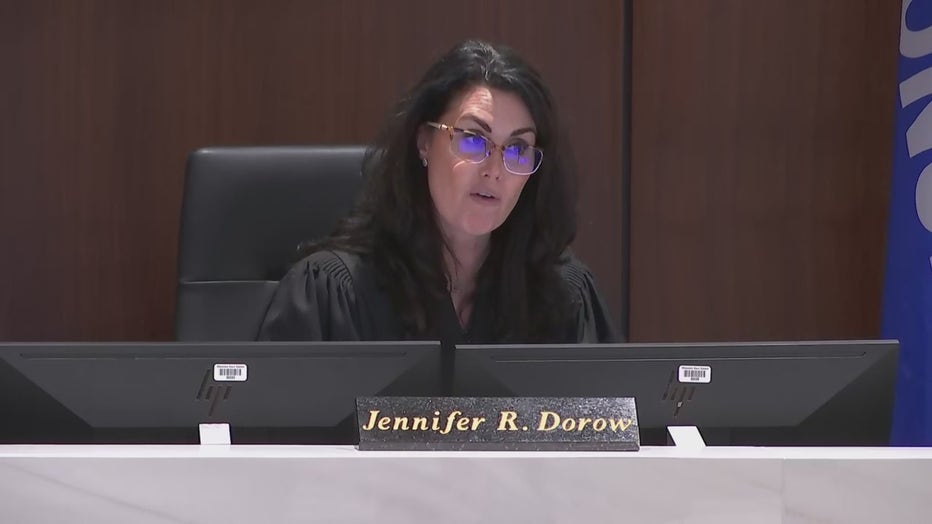
Judge Dorow
"I vehemently object to that," said Brooks, requesting "a legal or factual basis for your ruling."
Dorow said she would not reconsider any of Brooks' requests. He asked if he could request a written finding of facts and moved for an appeal on the matter. Dorow denied the first and said she was not the one to rule on an appeal.
The judge again said she was going to bring the jury out and allow him the opportunity to deliver a closing argument. Brooks interrupted, saying she was trying to put him under a rule that applied to no one else. The judge said the circumstances "and your insistence on arguing jury nullification" required her to do so.
Opper presented an alternative, saying that the defendant would reference jury nullification within the first three seconds the jury is in the room. She said Dorow should let him make his statement., and Opper would object. She said the judge could instruct to disregard that and tell Brooks to move on.
"We could at least try to, by merely objecting and the court telling the jury to disregard and the court telling Brooks to move on to another topic, we could at least try to allow him to present a closing argument," said Opper.
If that was unworkable, Opper said the record would be very clear as to the efforts of the court.
"Frankly, you have told them, and you will tell them that closing arguments are not evidence and I think they will abide by that, so I know it’s going to require effort for the court to allow Mr. Brooks to try and proceed, but I think we should try that in an effort to get through this next step. Or else, we will continue at this pace forever," Opper said.
Dorow said she was "certainly willing to try that in this (main) courtroom." The second step would be removing him from the main courtroom. The third step would be forfeiture of his right to deliver his closing argument.
Brooks' closing argument
Brooks then began presenting his closing argument to the jury.
"Good afternoon. It’s been a long day. First off, I’d like to start off by letting you guys know, that there’s a lot of information that you guys should be privy to, I believe, and one thing that I believe that you have not been privy to is the truth of your rights and your duties being the jury. The fact that you and you alone, have the power, not well-prepared DAs with well-prepared and clearly rehearsed speeches, exhibits, a lot of theatrics. Frankly, not the judge. You and you alone have the power. You and you alone decide what is truth and what isn’t truth. You should be informed that you have the power to nullify any law that you don’t agree with," said Brooks.
An objection from the state was sustained. The jury was told to disregard Brooks' nullification statement.
""I believe that not only is it fair, but it’s essential that you be privy to all knowledge, not knowledge that certain people feel that you should hear and shouldn’t hear disguised under the color of law," Brooks said. "The fact of the matter is, just like I did with my opening statements, I don’t have a well-prepared or rehearsed speech. I didn’t look in the mirror and say certain points to myself over and over again to make sure I have them right or anything like that. I’ve chosen to speak from the heart in my opening statements and now. I’m going to speak from the heart. What you won’t hear me do is argue facts, and the reason you won’t hear me argue facts is because I believe that it takes away from what should be recognized, the tragedy of this event."
"It’s a little emotional. I apologize for the long pause," said Brooks, taking a deep breath. "It’s hard to keep everything together emotionally, and honestly, I don’t believe that I have any more tears left. It’s been a hard year for the families, mostly, and that should not be lost on anyone and it shouldn’t be taken away. I said it before and I’ll say it again. There’s a lot of people that are healing, that are attempting to heal."
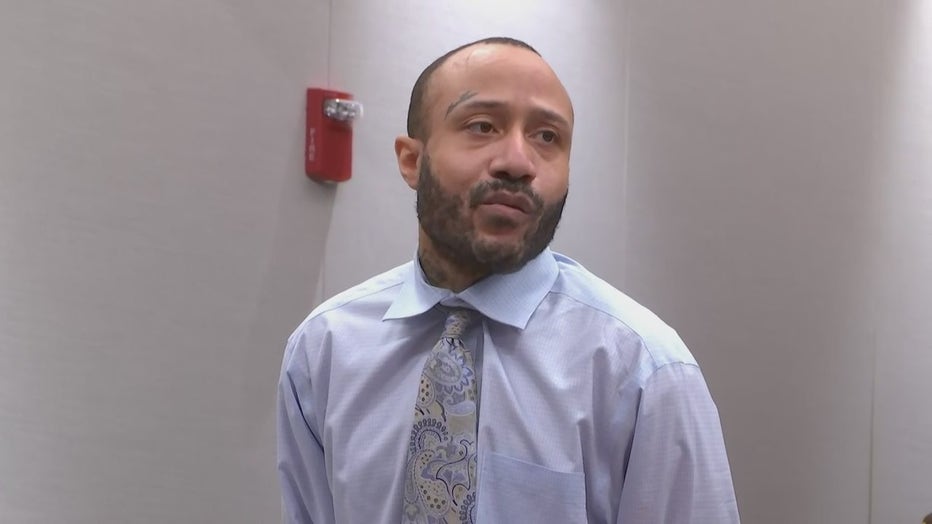
Darrell Brooks delivers closing argument
"That opens the door to talk about forgiveness for a little bit. With every healing process, there comes a forgiving process," Brooks continued. "It’s not an easy thing for anyone. What you’ve been hearing from the prosecution, not to take anything away from them, but let’s call it what it is. You’ve been hearing a lot of reruns, same things over and over, no different when you turn on the radio, and you first hear that song that you don’t like when you first hear it...and then you go, 'I hate that song. Why am I singing it?' That’s what’s been happening. Rerun, over and over and over and over. Attempting to make things stick in your head that simply aren’t true. Why do I say what I’m saying? I say look at the testimony. The thing from the prosecution here has been intent, intent, intent, intent."
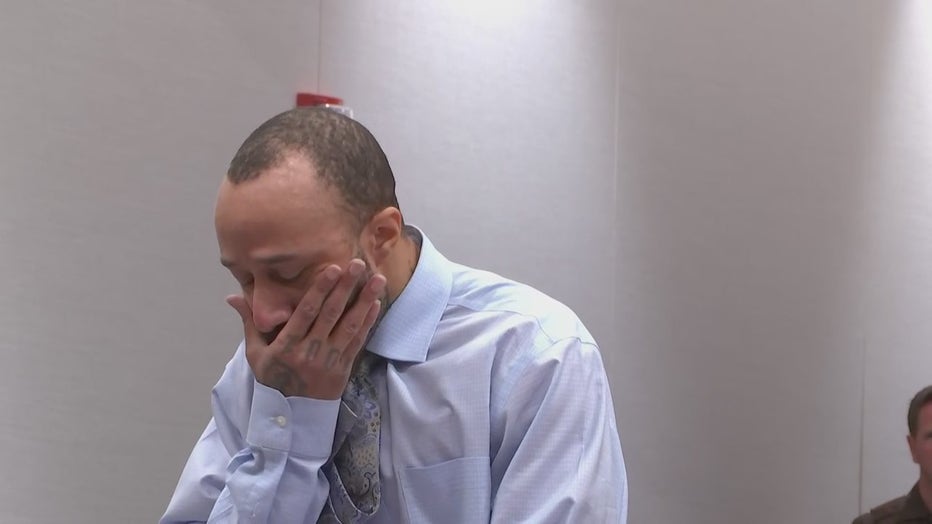
Darrell Brooks delivers closing argument
"We all know what’s been said. We all know the picture that’s been painted. Even the prosecution said themselves. How can you look in someone’s head and say this is what they intended to do?" said Brooks. "For a year, I’ve sat and gone through this feeling so powerless, letting other people run with the narratives, sitting back helpless while other people paint a picture that has zero truth. Zero."
"I understand about healing oneself, tragedy, pain, all that. A lot of it, there’s no need to get into. I, myself, in my own life, have had to do a lot of healing. As a man with children myself, I find it hard to believe that anyone who’s really had conversations with me, spent time around me would think for one second that this is an intentional act," Brooks continued.
"I’ve never heard of someone intentionally trying to hurt someone while attempting to blow their horn… while attempting to alert people of their presence, which brings me to more information that I believe that you should have been privy to, and I’m sure that the prosecution will beg to differ, but the fact of the matter is the vehicle in question, make and model of 2010, Ford Escape, the vehicle in question actually 2008, 2009 and 2010 of that model was in fact recalled," said Brooks.
An objection from the state was sustained.
"It’s information that you should have been privy to. Vehicles that malfunction and accelerate, not being able to be stopped," said Brooks.
An objection from the state was sustained.
"This is information that I feel like you needed to know, you should’ve known, information that was taken away from you. Why? To prove a case? Information that you definitely should’ve been privy to," said Brooks.
"The DA says the defendant has utter disregard for human life, utter disregard for human life, not realizing that they’re talking about someone that, again, has children, talking about someone that watched their children come out of the womb, cut the umbilical cord, held them even before their mom did -- moments that I’ll never forget, and yet, they say disregard, utter disregard for human life," said Brooks.
"They made reference to a rage as if they were or if this particular DA was standing right there, as if this DA is a psychiatrist," said Brooks. "I said to myself, ‘What rage? What do you mean rage?’ How can you characterize that? How can you have the audacity to diagnose what someone’s brain is, where it’s at, what it’s thinking, why it thinks the way it was?"
"The DA references blocks of people not being injured but then says it’s intentional. You add that up with the supposed rage, the supposed intent to harm and kill, and it doesn’t kick in until, well, within blocks?" Brooks continued. "And maybe it’s just me, but I would think if I was characterized as someone with this intent to kill and this rage and this anger then why weren’t people immediately harmed? Why would someone with intent to kill and rage try to alert people of their presence, repeatedly honk their horn? You heard a detective testify, if you recall… so where does this rage kick in? Where does this … intent to kill kick in?"
"What if the vehicle couldn’t stop because of the malfunction?" Brooks asked the jury.
An objection from the state was sustained.
"What if the driver was unable to stop the vehicle? Because of that fact, if the driver panicked, does that make the driver enraged and intent on killing people?" said Brooks.
Brooks referred to a video played by Opper during her closing argument.
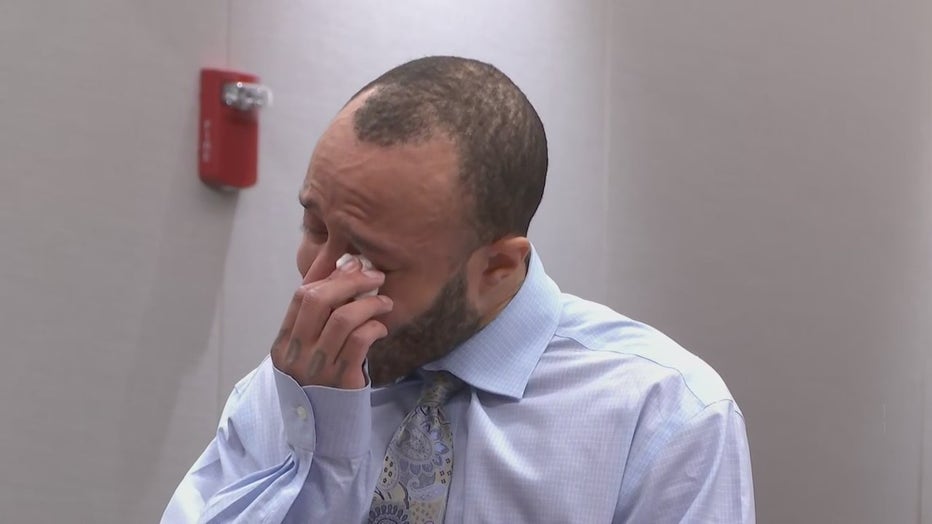
Darrell Brooks delivers closing argument
"You don’t see anyone striking that vehicle. On that exhibit, you don’t see anyone struck. Would someone who had this intent to kill, this rage as she says, if that was their intent, wouldn’t they have taken the opportunity to hit as many people as they could? Target people, mow down people?" said Brooks.
Brooks referenced the damage to the red SUV. He said the state said the damage was caused by bodies, but then said the vehicle hit barricades and other objects.
"The DA wants you to believe that this all came from people," said Brooks. "Evidence doesn’t support that."
"So I go back to trying to wrap my head around everything that’s happened in the last year, praying for those families, praying for the people that tragically lost their life because that should not be lost either," Brooks continued. "The fact that there was lives lost, and all the emphasis has been put on the alleged defendant and the people have been disregarded, makes me wonder, does the DA even care about those people?"
"There’s been prayers going up every day. There’s been suffering on both sides. There’s been threats, hate mail because of the narratives that’s been put out there, the misconceptions that have been put out there, the lies that have been put out there, lies that have caused my children not to be able to go to school, to be bullied, for my mother to have to leave her home and stay at a hotel because she’s afraid for her safety because she gets hate mail shoved through her mailbox. My nieces and nephews, for their safety," said Brooks.
"And what’s been equally hard is not only having to answer questions from my daughter, who was 7 at the time, my baby girl who was 7 at the time, who is now 8, attempting to answer her questions that she’s asking and still continue to shield her from what she sees, what she hears, having a newborn son that I haven’t even been able to meet, haven’t been able to hold, touch, kiss, having to navigate everything that comes with this whole situation while still attempting to wrap my head around it," said Brooks. "I can’t honestly say how many times I’ve sat in my cell, especially during lights out, alone, where it’s just you and just been praying and asking myself, ‘How could this happen?’ -- not just for the people but for everybody involved, the community, too. How could this happen? How?"
"The hardest questions you can ask is those that don’t have answers. No matter how much thinking you do, no matter how much you try to look at it from different perspectives and listen to other outside perspectives and listen to people that you trust and love, still coming up with nothing, but to think for one second, one question I never had to ask was if this was intentional. That’s something that never even.. I never asked once, because I know it wasn’t," said Brooks. "As a matter of fact, it never even crossed my mind to attempt to ask myself that because I know it wasn’t, and I know sometimes, during this trial, it probably doesn’t show, may be hard to believe, but trust me when I say no one outside of the families that have to go through this, no one’s heart is in more pieces than mine."
"So again, I go back to all these exhibits, go back to everything that’s been shown, everything that’s been testified to, everything you’ve heard during this whole process and this trial, and again, I say the same thing that I said earlier, same thing I said in opening statements. I’m not reading from any paper, any books. Everything you’ve heard in opening statements, everything you hear right now is from right here [beats chest]. Everything," said Brooks.
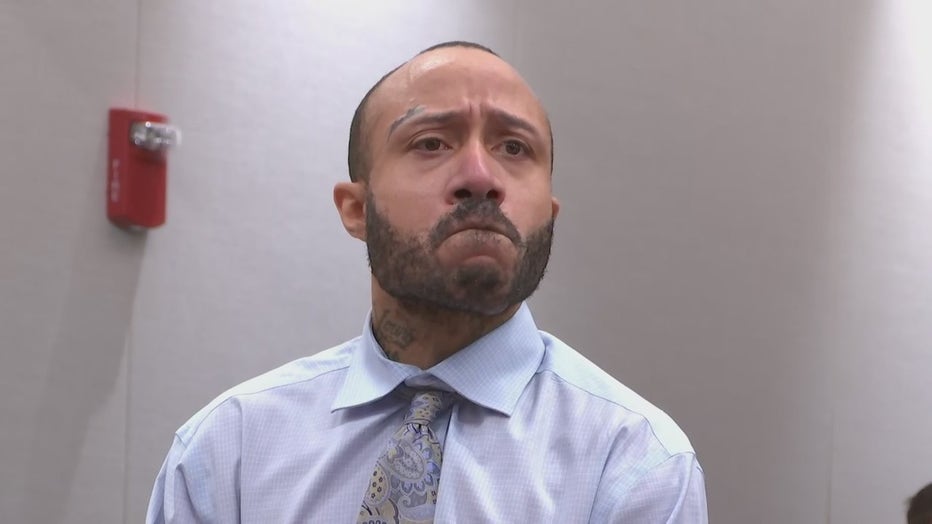
Darrell Brooks delivers closing argument
"You have the decision. You and you alone. All of you. You have the decision. I’m sure you’ve taken a lot of notes during this process. Some days are longer than others. Lot of movement in and out of the courtroom for various reasons," said Brooks. "Remember the power that you have. Don’t for one second let it be taken away from you."
"I can never understand the position of sitting on the jury in something of this magnitude, so I’m sure there’s a lot of pressure," Brooks continued. "I pray that the right decision is made."
"It’s almost like that message, or not message but that writing when we’re riding in our vehicles and the mirror says things are closer than they appear, but it’s also that things aren’t as they appear. I can’t speak for anyone else, but me myself. I believe in Jesus Christ. It’s how I was raised. That’s what I believe in. None of us are perfect, but I try every day to make sure that I acknowledge Him. That’s why every time I step in this courtroom, I have my Bible with me everywhere I go. I even read it on breaks, recesses. This is not something that started at the beginning of this incident. This is something that’s been instilled in me since I came out of the womb. This is how my family lives their life. This is how we was raised," said Brooks.
"For whatever mistakes that I, myself, have made, I’ve made peace with God. I’m happy to say that my conscience is clear," Brooks continued. "And because I believe, I trust Him with my life. Nobody will ever know why it was His will for this to happen. A lot of lives were changed that day, mine included. God's way is not our own, and no matter how many times you want to question, we have to have faith."
"Look inside yourself," Brooks told the jury. "Look inside yourself, and make the right decision. Look inside your heart. You have everything in your hands now. Everything. Do what's right. Do what's right. Don’t let the smoke and mirrors take away your power. Don’t let the theatrics take away your power. Each and every one of you has a decision. Do what's right. Make the right decision."
"It’s hard to think about my younger kids getting older and, at some point, having to explain everything to them," Brooks continued. "Kids don’t stay kids forever, and nowadays, kids are, frankly, a lot smarter than we were when we was kids. I’ll tell you that much. I got a letter the other day from my youngest daughter, and she’s still learning cursive right now so she isn’t the best writer when it comes to cursive. She’d rather print. She said, ‘Dad, why are people saying all these mean things about you?’ I haven’t read the rest of that letter yet. The rest of that sentence said, ‘That’s not the dad I know.’"
"Throughout this year, I’ve been called a lot of things, and to be fair, I am a lot of things," Brooks told the jury. "Murderer is not one of them. Never has been. Never will be."
"So before I close my statement, I just want to say open your hearts…" said Brooks. "Go inside yourself when making this decision… I have no fear."
"Pray and do what you know is right, what you know is right," said Brooks. "Think about everything you’ve heard. Think about everything you haven’t been privileged to hear. Think about the whole entire picture, and above everything, whatever you decide, make sure you yourself can live with it. Make sure you can live with it. That's the magnitude of the power that you have. Just like this tissue is in my hand, this is everything. You have everything. Be at peace with what you decide. I have no regrets. Don't let this decision weigh on you after it's over."
"Don’t look back and kick yourself in the behind," Brooks told the jury. "Spent about three weeks with you, and it took a lot of courage and a lot of guts to pause your life for this, to put important things on hold, to basically stop your life. You should be commended for being able to sit up here with this amount of pressure. I want you guys to know that’s not lost on me. I’m sure it’s a lot, and you all should be commended because it took courage to do this. I don’t know, but I would bet a lot of people wouldn’t want to be sitting in your position right now and you guys had the guts to do it. Thank you for that. Thank you for taking pretty much a month and setting it to the side for this. I know it's probably not proper, but you guys deserve a round of applause if you could get one."
"I believe you know in your heart what’s right. Thank you," Brooks concluded.
Opper's rebuttal statement
Opper had 13 minutes and 28 seconds left of the allotted one-hour period for closing arguments to present her rebuttal.
"Folks, let me just say this. Mr. Brooks stands here and professes to speak from the heart… He talks about his children. He talks about the hardships he’s encountered, and he brushes over the loss to the community. He wants to talk about he’s never held his newborn son. Never once acknowledges the Sorenson family, the Owen family, the Durand family, the Hospel family, the Kulich family, the Sparks family," said Opper. "It’s nice Mr. Brooks can get letters from his loved ones. I don’t know why Mr. Brooks did this, but actions define a person."
Opper went on to say, "You can hold a Bible and profess what you may be, but when you drive over children with band instruments, your intent is known, Mr. Brooks."
"You don’t have to stand and wonder, as he claims to, for him to keep going after he drove over those children in the band and have Jackson Sparks fly off the front hood of his car, lifeless, and keep going and have Jane Kulich fly off the hood of his car, run her over and keep going. I’m not going to go on. You get it," said Opper. "You need to look in the mirror, Mr. Brooks, if you want to accuse me of practicing my closing argument… Your actions are that of a murderer. You murdered these six people. You endangered the safety of 60 others. That’s not an accident. That’s not a, ‘Gee, I woke up one day and don’t know how I got in this position.’ If you have some explaining to do to your children Mr. Brooks, I recommend you do it."
The judge then began delivering additional jury instructions to the members of the jury before selecting the alternate jurors from a tumbler.
Jury deliberations begin
The jury was excused for deliberations at 6:24 p.m.
The jury went into sequestration, meaning they would remain together in a secure location until a verdict is reached. The judge said the alternate jurors would be in a separate jury deliberation room to be called upon as needed.
As the case was handed over to the jury, Brooks asked whether he would be required to stay in the courtroom while the jury deliberated, noting it was "shower day" in his pod at the jail. The judge said she understood but said she wanted him around in case the jury had questions.
Brooks then asked about the 68 recklessly endangering safety charges, asking how they could be on the list if they didn't testify. The judge said there was sufficient evidence provided by the state.
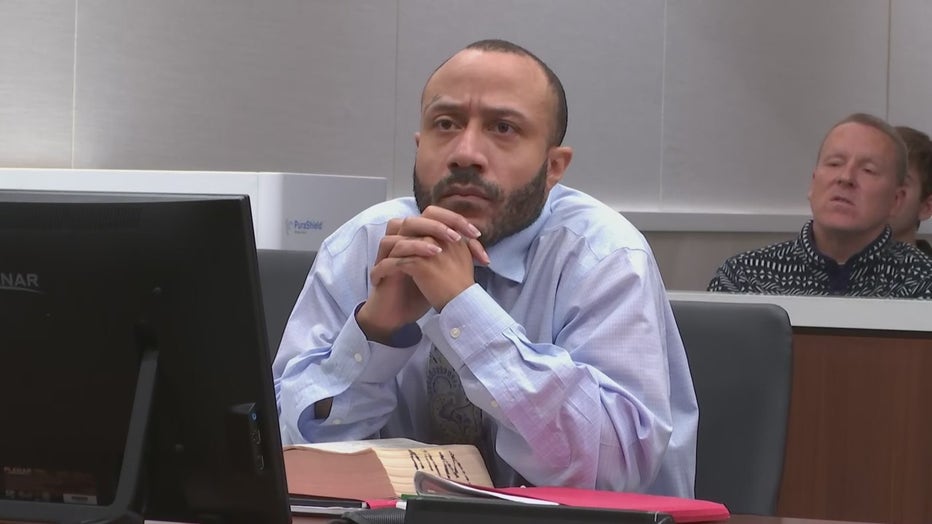
Darrell Brooks in court Tuesday, Oct. 25
Brooks asked if he could get his "filings," and the judge said he could have his originals back if the clerk was able to scan them in.
The court went into recess until 7 p.m.
There are 76 individual criminal charges against Brooks. The jury has to vote on each one. Assuming they follow the instructions, that is 107 pages of material to work through. So even if they are unanimous in their views of his innocence or guilt, reaching a verdict on all 76 counts could take time.
Earlier Tuesday, Judge Dorow said upon a conviction, she would ask both parties to come in on Monday, Oct. 31 to address how many people may wish to speak at sentencing.
Post on Justice4Darrell sub-Reddit claims to be written by jury member
Around 7 p.m., Judge Dorow notified the parties about information from clerk of court she had received an email from someone who found a post on the Justice4Darrell sub-Reddit on Reddit; the poster claiming to be a member of the jury pool.
"I am going to provide the parties with the information I was given this morning," said Dorow. "It's a color copy of the attachment and the email that was sent. The email was received by the clerk of court at 9:10 a.m. Then my clerk received notification at 9:30 a.m. that the clerk of court wanted to speak with me. You may recall, this morning, I stepped off the bench for a little bit of time. I read through the information that was provided to me which was an email and then the attachment...looks like the person took a screenshot and that the anonymous post claimed to be a member of the jury on the case, and here are my thoughts on the trial and on this sub-Reddit," said Dorow.
Dorow said the matter was turned over to law enforcement for a full investigation.
"I made a determination I would not stop what was happening in terms of the trial," said Dorow. "I am concerned about the integrity of these proceedings, and I will take whatever action that I deem appropriate once a full investigation is done," said Dorow. "At this point, there is no credible information that this is, in fact, a member of the jury, but I will leave that for law enforcement to determine and, if need be, at the conclusion of the case, when the jury reaches a verdict, I certainly will consider whether any questioning of the jury is warranted."
Brooks had questions about what Reddit is.
Opper said her office received similar emails, and all the emails referred to the same posting. Opper said, "We question the veracity because some things are not true -- it doesn't present material prejudice."
Opper added that the posting was largely critical of the court and the prosecution.
Brooks said it must have been written by someone on the jury or someone with knowledge of the trial.
Dorow said anyone in the world could be watching the trial.
Later Tuesday evening, the post was updated with the message: "This was all a prank, I didn't think this would blow up like this. We are sorry. Love, rdrama."
Jury quickly requests exhibits
Opper then asked whether they would need to meet every time a jury member had a question.
The judge noted jurors could ask to view photographs, written documents or videos.
Dorow said it was possible to have the videos played in the jury room and in the courtroom simultaneously.
The number of exhibits was discussed, and Brooks said he wanted the judge to rule on each exhibit as to whether the jury would be able to view it again.
Dorow said she would allow the jury to deliberate "as long as they want" Tuesday night.
The jury quickly asked to see three exhibits, one of them the map presented by the state that lays out where the victims and police officers were during the parade attack.
Brooks objected to that.
"It's been seen a million times now," said Brooks.
Dorow said they could see it.
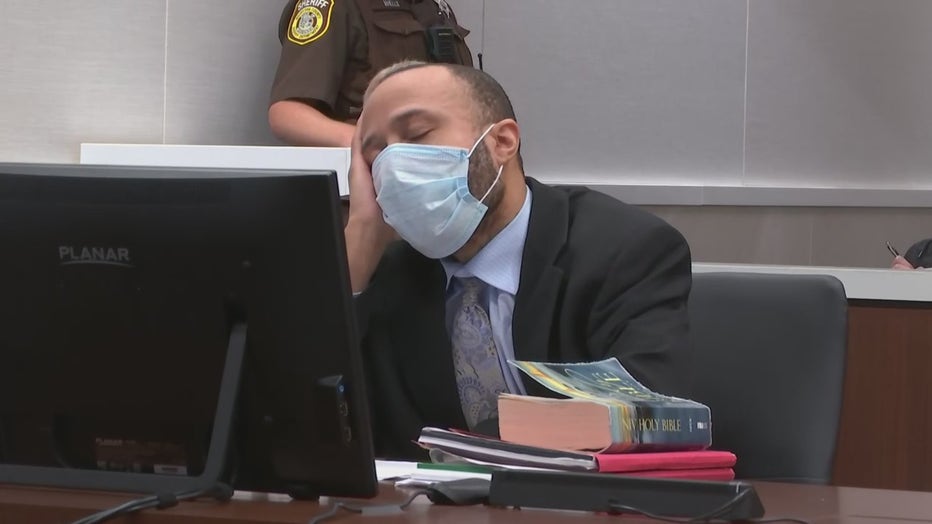
Darrell Brooks in court Tuesday, Oct. 25
Another exhibit the jury requested to see again was the photograph of Erika Patterson, Brooks' ex-girlfriend, related to the battery count connected to the fight prosecutors say happened near Frame Park before the parade attack.
Brooks objected to that, as well. Dorow allowed the jury to receive that exhibit.
The third exhibit requested by the jury was the video from Couri Insurance of the Milwaukee Dancing Grannies members being struck by the SUV. Brooks objected.
Dorow allowed it.
"I’ll just let you rule on it," said Brooks. "There’s so many videos, it’s kind of like the same video anyway."
As Dorow stepped off the bench, Brooks giggled and asked, "Subject matter jurisdiction, your Honor? Are you going to address it?"
The jury then asked to watch video of the Milwaukee Dancing Grannies being hit – asking that the video be shown to the jury members at 40% speed. Testimony in the state’s case showed Brooks "zigzagging" through the Grannies. In her closing, Opper stressed that proved intent.
Brooks again brought up subject matter jurisdiction.
"Of course, it’s denied. You can’t prove it on record," he said.
The jury soon requested two more exhibits, video taken near Frame Park where prosecutors say Brooks got into a fight with his ex-girlfriend before the parade attack.
Shortly after 8 p.m., the jury came back into the courtroom to break for the night. They did not return home; sequestered during deliberations.
Christmas parade attack
Prosecutors say Brooks drove a red SUV through the parade route on Nov. 21, 2021, killing six and injuring more than 60 others.
FREE DOWNLOAD: Get breaking news alerts in the FOX6 News app for iOS or Android
On Nov. 21, 2021, according to prosecutors, Brooks met up with his ex-girlfriend in Frame Park, the same woman he is accused of running over with his red SUV earlier in November 2021. She told police they argued in his SUV before he started driving, and he "was driving around with one hand and striking her in the face with his other hand." She eventually got out and called her friends for help.
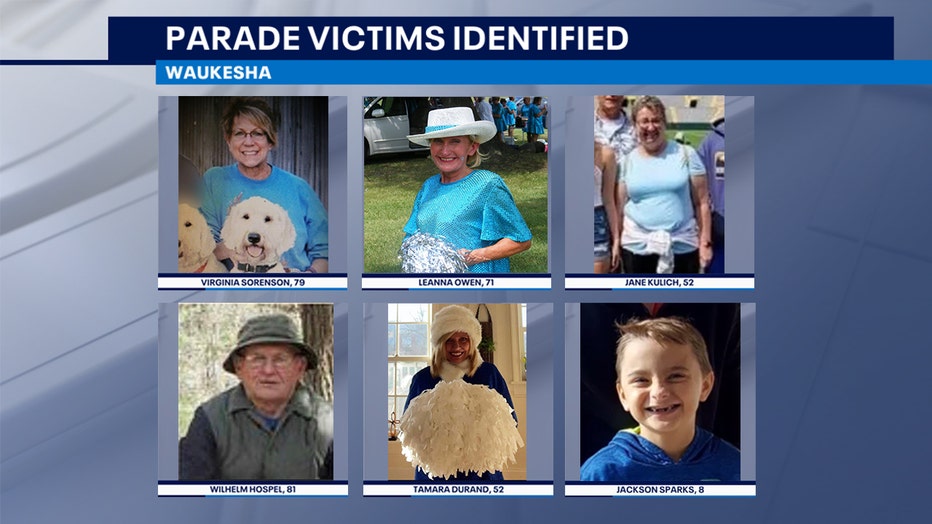
Waukesha parade attack victims identified
Soon after that, according to prosecutors, Brooks drove that red SUV through the parade route, killing Jackson Sparks, 8, Virginia Sorenson, 79, LeAnna Owen, 71, Tamara Durand, 52, Jane Kulich, 52 and Wilhelm Hospel, 81. More than 60 others were hurt.

